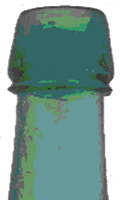* The deposit and refund value must not be less than 15 cents for wine and spirits, and 5 cents for all other beverages.
* On printed labels, the refund value and the word "Maine" or the abbreviation "ME" shall be clearly and conspicuously displayed on every beverage container using letters, numerals and symbols.
* The deposit logo must not be less than 1/8 inch high in clear and prominent typeface and a color contrasting with its background. The refund value shall not be indicated on the bottom of the container.
* On metal beverage containers the refund value and the word "Maine" or the abbreviation "ME" shall be embossed, incised, or printed clearly and conspicuously on the top of every beverage container using letters, numerals and symbols not less than 1/8 inch high.
* Additionally, if a manufacturer directly prints, embosses, or incises the Maine redemption value on the beverage container, the manufacturer or in the case of a private label, the brand owner must submit such labeled container, such as incised can or jet printed bottle to the Department of Agriculture, Food and Rural Resources, Division of Quality Assurance and Regulations for approval. Placement suitability and security of the mark will be examined.
* With the exception of wine products, all beverage containers sold in the State of Maine shall bear a Universal Product Code (UPC) for that product.
* Beverages, when sold as a multi-pack unit, must have a UPC on each individual beverage container.













